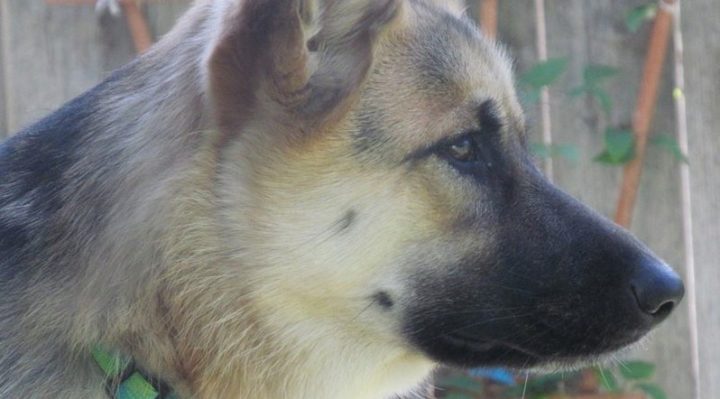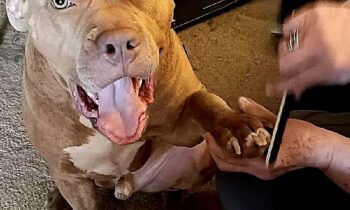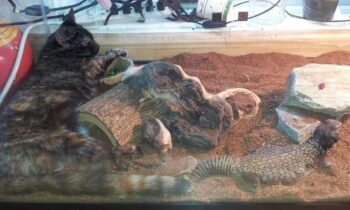
Does your dog like to dig? Is that creating unsightly and sometimes dangerous holes in your yard? Are plants and trees being destroyed? Is your dog coming inside covered with mud and dirt?
For many dogs, digging is a naturally rewarding activity. Northern breeds, like huskies, dig indentations big enough to lie in, often under porches or decks, and are seemingly hardwired for this behavior. Terriers and other “earth” breeds are also natural diggers, in search of rodents or simply because they can. Dogs with no other reason dig because they are bored outside, in need of more environmental stimulation.
There are many ways to discourage your dog from digging—some punitive, others simply management techniques, like fencing off areas you wish to keep pristine. But why punish or preclude an activity that gives your dog both exercise and relief from boredom?
Instead, give your dog an acceptable outlet for his digging, in a controlled situation that limits damage to more vulnerable parts of your outside areas. Build your dog a digging pit—it’s easy and relatively inexpensive—then redirect your dog’s digging efforts to this one place in your yard where digging is okay!
- Find a spot in your yard that’s as far away as possible from vulnerable plantings. I’d recommend placing your dog’s digging pit where it is visible from inside your house, if possible, and easy to see from your back porch or deck, since at first you’ll want to supervise your dog’s use of the pit.
- Consider, too, placing the pit some distance from kids’ play areas, for example, and away from areas where humans relax, like patios, fire pits, or barbecues.
- Most important: if your yard is accessible to cats—your own, your neighbors’, or strays—a cover for your dog’s digging pit is mandatory. . . for obvious reasons!
Not sure about where to place a permanent digging pit? Concerned about cat, um . . . usage, shall we say? How about a temporary digging pit instead? You can use a plastic kiddy wading pool (very inexpensive) as the pit, with another same-size wading pool as a cover. Either figure out a way to clamp the two pool shells together or place rocks or bricks on the “top” pool to hold the cover down securely so your dog will not find—and consume—what we lovingly call “kitty roca” from the pit.
No cats, but you’d like to opt for a temporary digging pit anyway? No cover is necessary. Kids may be tempted to play in the dog’s digging pit, though, so rules about its use are up to you. Be very careful about kids leaving their own toys in the pit. That will certainly give your dog the idea that those toys are okay for a dog to play with and chew. Nope! You don’t want your dog ingesting plastic or metal pieces from the kids’ toys, so be clear: anything left in the dog’s digging pit is fair game for the dog. You cannot fault the dog if that rule is not followed by human family members.

Temporary pits made in above-ground containers like kiddy wading pools require little preparation.
- Place the kiddy pool on grass and you will either have to move the pool often—not easy when it’s filled with sand—or tolerate dead grass under it.
- Placing the pool on cement or brick might be better, if either of those surfaces is available.
- An uncovered pit needs drainage if it’s placed where water can get in (from either rainfall or your sprinkler system), or you’ll end up with a sloppy mess. Consider poking holes in the bottom of the kiddy wading pool to allow water to drain out.
Permanent digging pits require . . . digging! Find the perfect spot and man (or woman) the shovels.
- The hole you dig does not have to be any particular size, but I suggest starting small. You can always dig more and add size to the pit later if it seems appropriate.
- I highly recommend lining the hole you dig with layers of old newspapers before you go any further. The newspapers will eventually compost into mush, but in the meantime they act as a barrier to prevent weed and grass growth in the pit itself.
- You might also look into organic, non-harmful alternatives to weed killers for treating the soil of the pit before you add the sand. Please, no chemical sprays! Your dog will have his face and paws in that pit and you don’t want to chance any harm to his system.
Once your pit is prepared, it’s time to add the sand.
- Your best bet is called “play sand,” the substance used in children’s sandboxes. It’s probably good to locate a source for play sand before you dig the pit, of course, to make sure you can find it in your area!
- Play sand should be available at any chain home improvement store, builders’ supply, or landscapers. It’s relatively inexpensive, comes in sturdy sacks that weigh about 50 pounds each, and is free of any detritus. It’s safe for children, so you know it’s safe for dogs.
- Other sand-type substances may be available where you live, so look around before you purchase.
- Plan to spend around $50 for sand to fill a reasonably sized digging pit. The sand will settle, so consider buy extra sacks to use later.
- Fill the pit with play sand, water it to help the sand settle, add more sand as needed.
(Should you build your pit “in ground” surrounded by lawn, don’t be concerned about any sand that escapes the pit when your dog digs or plays—it’s unlikely to be a problem for your mower. Of course, you can always use edging around the outside of the pit, or make a border of bricks or paving stones. Styling the pit surround is up to you. Make it as elaborate or as simple as you choose.)
Then the real fun begins—introducing your dog to the new digging pit!
- Place some or all of the dog’s outside toys in the new digging pit. Don’t cover the toys with sand at first—give your dog a chance to see them.
I’ve found that our sand pit is an excellent place to toss all the dog toys that are strewn on the lawn when I get ready to mow the yard. I avoid chopping up tennis balls with my mower that way, and my dog always knows where to check first for his toys.
- Once your dog has figured out where his toys will be, you may find he starts digging on his own in the sand pit. If so, no other action on your part is necessary.
- To up his interest and inspire further doggy digging action, try burying a couple of his most valued toys in the sand with only a little bit of the toy sticking out, enticing him to free the toy by digging.
I don’t choose to use food in this process myself, but that’s entirely up to you. Your dog will certainly be motivated to dig for any treats you may bury, and that could well get his digging interest activated. Use dry treats like hard dog biscuits rather than moist ones, to avoid any sand ingestion by your dog.
- Don’t let your dog get bored with the digging pit. Let him find a few surprises there regularly—a new outside toy, maybe an exciting stick, or one of his favorite hard biscuits—so that checking his digging pit becomes the second step of his every visit to the outside. (The first step is to eliminate, of course.) Play with him in the digging pit if you will. Dogs are copiers of behavior, so show him how you dig, too!
- Keep your dog’s digging pit clean by regular raking, removing anything that should not be there, guarding especially against kitty roca if you’ve chosen to leave the pit uncovered.
- Add play sand as the old sand settles and is kicked out of the pit.
- Expand the area of the pit if it seems appropriate.
Introduce visiting or new-to-the-household dogs to the pit individually. Be wary of any indication that resource-guarding (fighting to keep a particular toy or treat) might be activated in the pit. Use lesser-value toys, in multiples, so every dog can play with the toy he wants. Don’t use food treats at all if any of the dogs involved has a tendency to resource-guard. The digging pit should be a place to have fun, to find surprises, to exercise . . . not to have hassles with another dog!
Redirect digging in other outside areas by guiding and encouraging the dog to dig only in his digging pit. Fill inappropriate holes elsewhere with a scoop of the dog’s fresh poop, covered with dirt or rocks. Most dogs do not like having poop on their paws, and that may be enough to discourage them from digging in that hole again. (The poop will compost on its own.) If using the dog’s own poop does not work, cover the inappropriate holes with chicken wire or surround them with a temporary barrier.
Making a digging pit for your dog is a relatively easy task and not all that expensive unless you choose to make your digging pit the talk of the neighborhood for its size and style. Once your friends and family see how well the digging pit works to curb your dog’s unsightly digging elsewhere, everyone you know will want to build a digging pit for their own canine companion. Enjoy!



